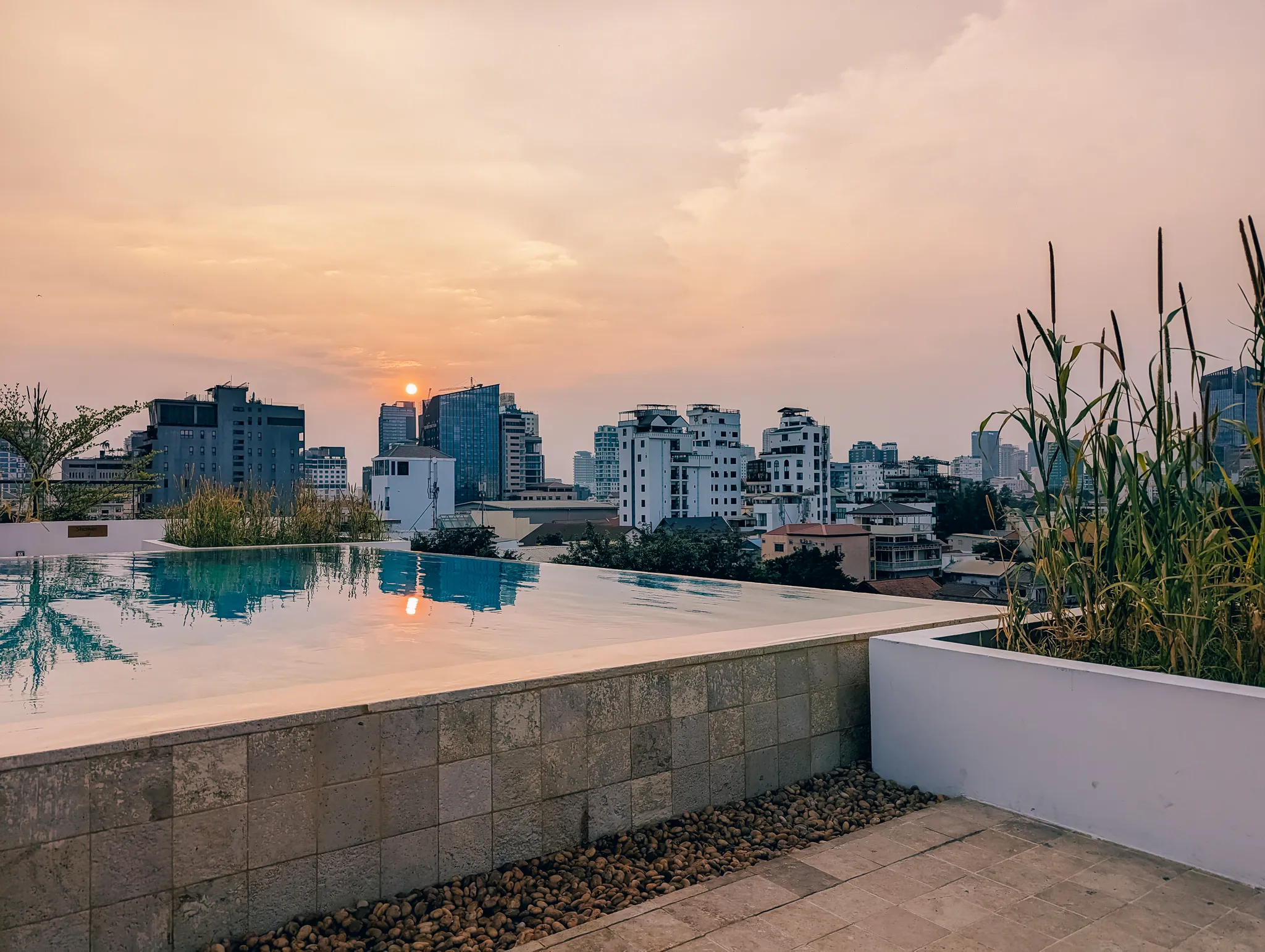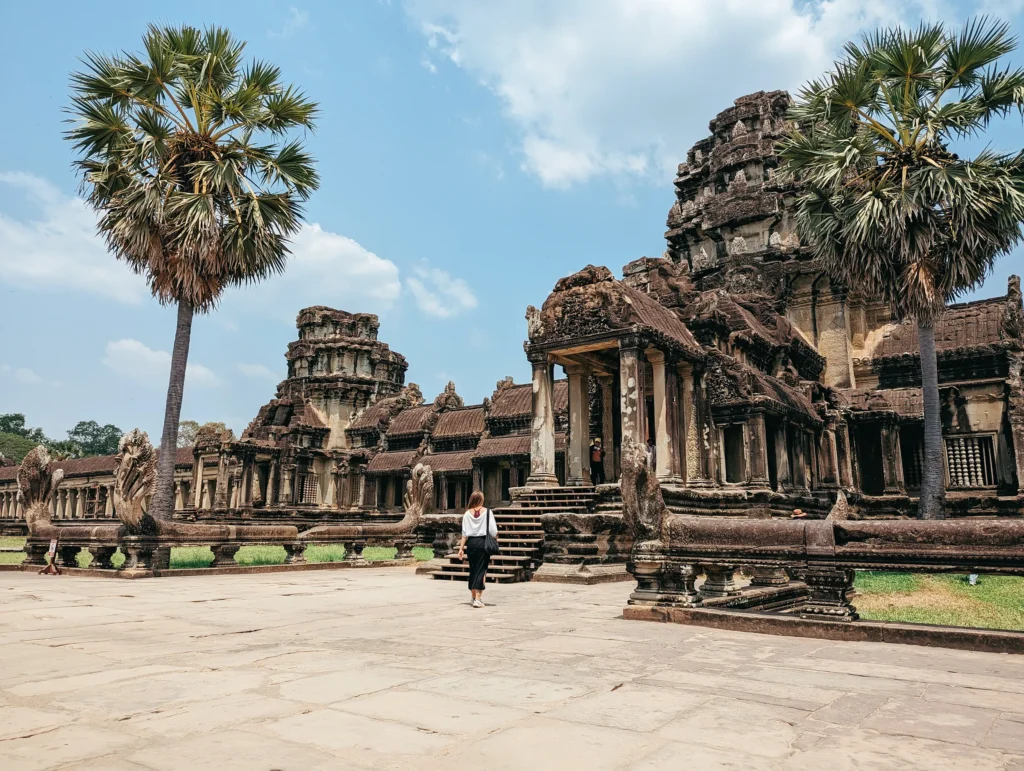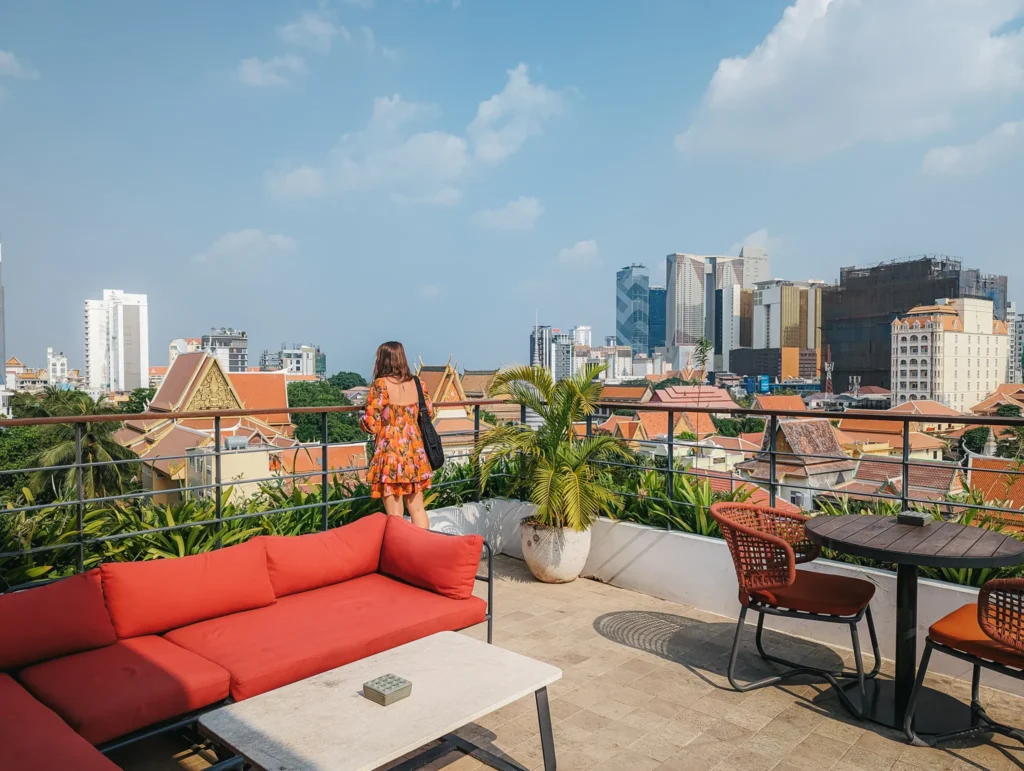Today I’m sharing my ultimate itinerary for spending 48 hours in Phnom Penh. From picking the perfect hotel, to knowing where to go, spend your time, eat and explore – hopefully this guide will help you plan your trip to Phnom Penh.
Phnom Penh is Cambodia’s capital city, and unless you’re flying in and out of Siem Reap, it’s pretty unavoidable. I read somewhere that ‘all roads lead back to Phnom Penh’ and it’s a pretty truthful statement.
I personally don’t think that Phnom Penh should be avoided. Before going, I heard really mixed reviews and most people’s sentiment was that they didn’t like the city… I don’t usually like big cities and I can’t say that I loved Phnom Penh, but I still think it’s an important place to visit on your first trip to Cambodia.
Cambodia has a recent dark history that it’s important to learn about on your trip – and the best place to do that in the Genocide Museums in Phnom Penh. So while I don’t love big cities, I would recommend planning at least 48 hours in this one, to really get an understanding of the history of Cambodia and the Khmer Rouge.
Phnom Penh is also a great jumping off point for all of the other areas in Cambodia that you definitely need to visit.
So, if you’re here reading this, hopefully that means that you’ve decided to give Phnom Penh a couple of days, before heading off to explore the rest of what beautiful Cambodia has to offer.
Table of Contents
- Things to know beforex you go
- The best time to visit
- Getting to (and around) the city
- How long should you spend
- Where to stay
- 48-hour itinerary
- Cost of travel in Phnom Penh
Please note: This post contains affiliate links, meaning I may earn a commission if you make a purchase by clicking a link (at no extra cost to you). Thank you for supporting my blog!
Justyn’s Quick Phnom Penh Recommendations:
🏨 Stay: For your first trip to Phnom Penh, I recommend staying near the Riverside (Sisowath Quay). If you’re looking for a gorgeous hotel with a rooftop pool overlooking the city, check out Penh House Hotel. For something more budget friendly, find a private room at a hostel.
🍜 Favorite eats: I loved The Kathmandu Kitchen in Phnom Penh! Unfortunately Cambodian food isn’t the best for vegetarian food, and finding Nepalese food in any city is always a treat.
⭐️ Sightseeing: Don’t miss the opportunity to learn the heavy but important history of the Khmer Rouge in Cambodia. I recommend quietly exploring with the audio guides.
🇰🇭 Travel tip: Get connected fast with a Cambodian eSIM.
48 Hours in Phnom Penh itinerary overview
- Day 1: Wake up early to visit the Tuol Sleng Genocidal Museum and Choeung Ek (Killing Fields), eat lunch around the Royal Palace, explore the night market for dinner.
- Day 2: Visit the National Museum and Royal Palace, shop in the boutiques along Street 240, walk along the riverfront and take a sunset cruise.
Things to Know Before You Go
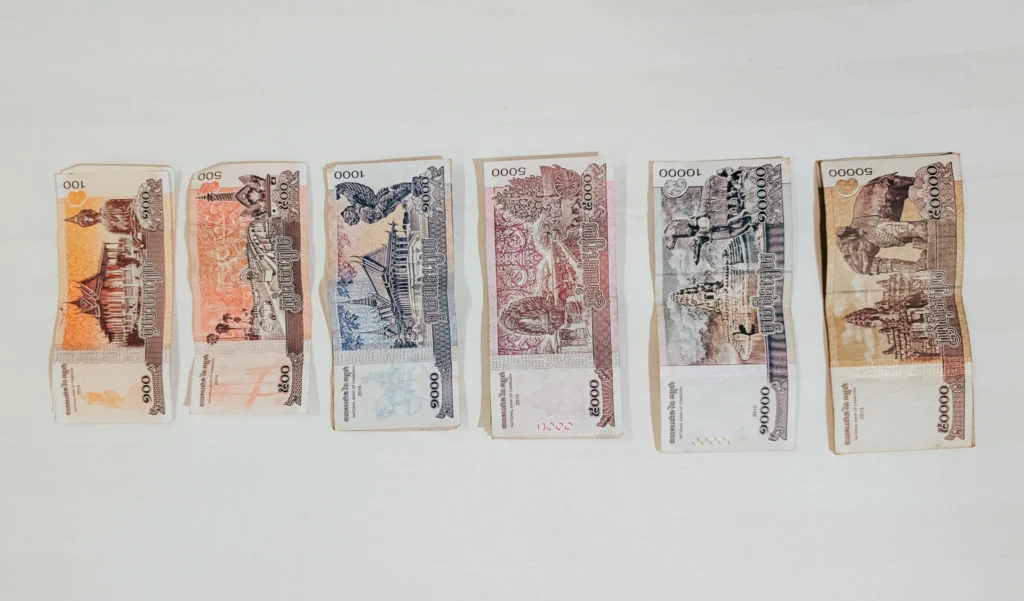
Money
The official currency of Cambodia is the Riel (KHR) but they also use and widely accept USD. Anytime you pay for things like street food, souvenirs or TukTuks in USD, they’ll likely give you change in KHR. In March of 2024, the currency conversion was widely accepted as $1 to ៛4,000.
You can take both currencies out of ATMs but be careful which ATMs you choose to take USD out of.
Nowhere in Cambodia will accept torn USD, and a lot of the ATMs will only give you $100 or $50 bills which are too big for most places to take. We got USD out of an ATM and it gave us a torn $100 bill and a $50 bill that had been written on – which were really hard to exchange for smaller bills because no bank would accept the torn or damaged money. To avoid issues like this, I recommend only taking USD out of ATMs that are attached to a physical bank branch, and taking the USD out during business hours – in case there is anything wrong with the bills.
You can always take KHR out of ATMs and people will accept any bills in that currency.
In Thailand, there aren’t many places that accept cards. It’s a very cash based country to travel in. We were surprised at the difference in Cambodia, there were lots of places that accepted credit cards.
Language
In Cambodia they speak Khmer. In Siem Reap and Phnom Penh you’ll find that most people speak enough english that it’s easy to get by. If you travel to other parts of the country, that might not be the case.
Here are some basic phrases:
- Hello: Suostei (pronounced Sous-Day)
- Thank you: Arkoun (pronounced A-Koon)
- Please: Saum
- I’m sorry: Khnhom Somtos
- Goodbye: Leahaey (pronounced Lee-Hi)
Safety
Personally I felt safe throughout the trip through Cambodia, including Phnom Penh. On this trip I wasn’t traveling solo, I was with my partner which drastically changes your experience as a woman anywhere in the world. But I can honestly say that I would travel around Cambodia and Phnom Penh solo.
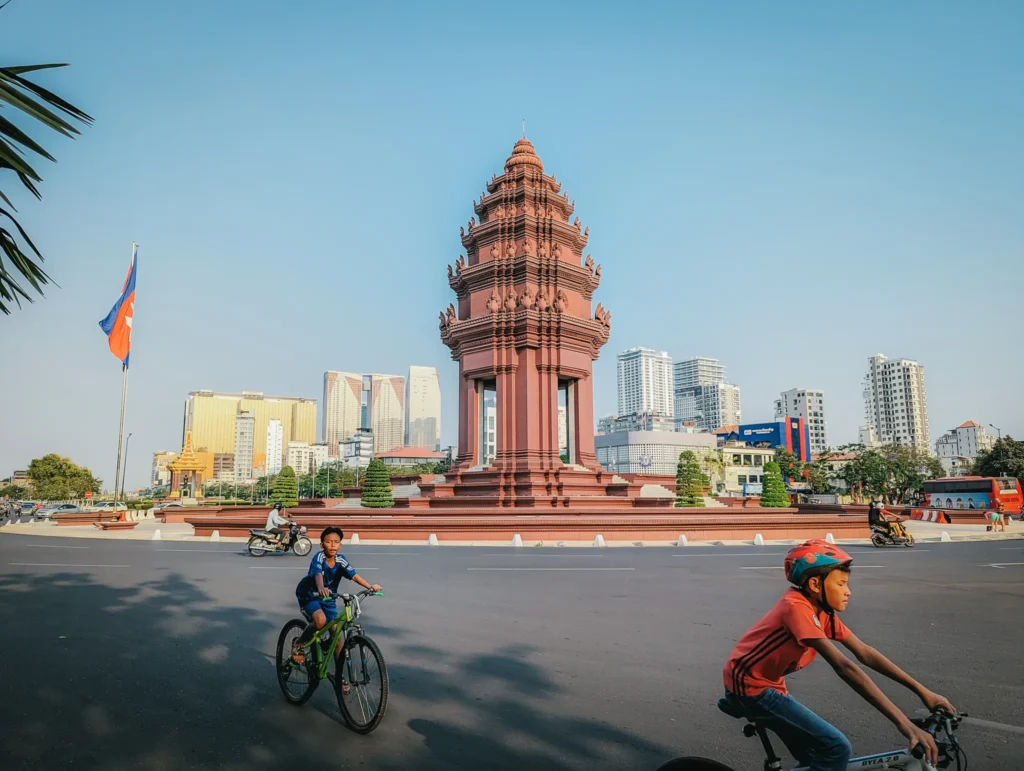
Planning Your Trip to Phnom Penh
Best Time to Visit
Cambodia has a tropical climate, with a wet and a dry season. That means for a good part of the year, it rains and for the other part, it’s dry. It’s hot at both points, but the dry season can be excessively hot.
Usually late November until January is the coolest time of year to visit (and the busiest!). March, April and May are the hottest and driest months of the year – and I highly recommend avoiding them. We went in March and it was too hot.
The wet season starts around June/July with the wettest month being September. From what I’ve read, the best time to visit Cambodia would be around September until November.
Given how much time you’ll spend outdoors in Cambodia, I definitely recommend making sure you’re going at a time of the year where you’ll be comfortable.
Getting to (and around) Phnom Penh
There are a few ways to get to Phnom Penh, you can fly into the International Airport (airport code PNH) or take a bus from another part of the country or region.
If you’re flying into Phnom Penh, it might be easier to arrange a pickup with your hotel. This will usually cost around $25, and you’ll be greeted at the airport, helped with your bags and dropped off at your hotel. We took a Rickshaw/TukTuk to the airport from our hotel near the riverside, which cost us $5 or ៛20,000 KHR.
We flew into Siem Reap and ended up taking a minibus and local bus into Phnom Penh. The bus will drop you off at the railway station and then we took a TukTuk to our hotel which cost $2 (we negotiated for this price).
We spent our entire time in Phnom Penh taking TukTuks, which will usually cost you between $1-2 for in the city and more if you want to visit Choeung Ek and other sites outside the city. Other than that, we walked! I always find that the best way to really explore any city is on foot.
It’s not really a city designed for walking… The sidewalks are often nonexistent or also being used by motorbikes, but along the riverfront and around the night market is definitely walkable!
How Long Should You Spend in Phnom Penh
I recommend 2-3 nights, depending on when you’re getting into the city. We knew that we would get into the city quite late on our first day, and leave very early on our last, so we decided for 3 nights.
Overall, two full days is more than enough time to visit all the sites I would recommend in Phnom Penh. Obviously you can stay a lot longer than that to get off the beaten path and explore the local side of the city!
Where to Stay in Phnom Penh
Phnom Penh is one of those cities where you can get beautiful accommodations with a rooftop pool for less than a cheap motel in America. Because of this, I love searching for hidden gems! When I start looking for accommodation in any city, I start by figuring out what neighborhood to stay in.
In Phnom Penh, I would recommend staying near the Riverside (Sisowath Quay).
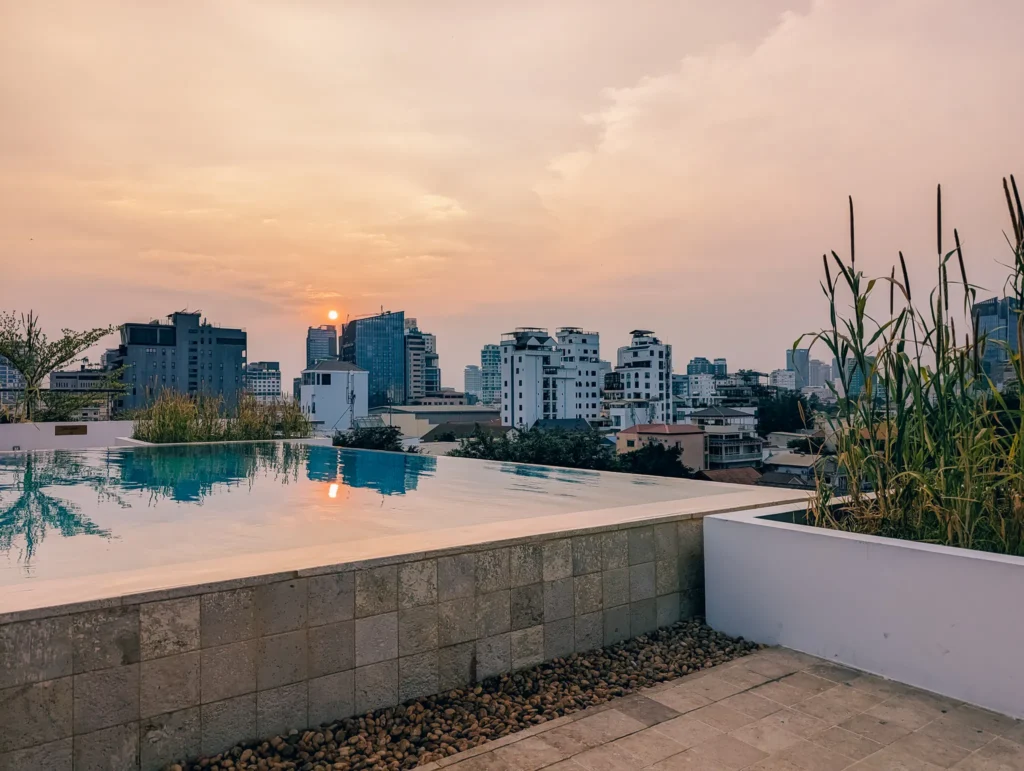
Top Hotel for Digital Nomads: Penh House Hotel (9.2⭐️)
We stayed at Penh House Hotel and it was perfect. Located on Street 240, you are only steps away from beautiful boutique shopping, the riverfront, and the Royal Palace. Penh House has a rooftop pool and a delicious breakfast! The restaurants serves delicious food for dinner as well.
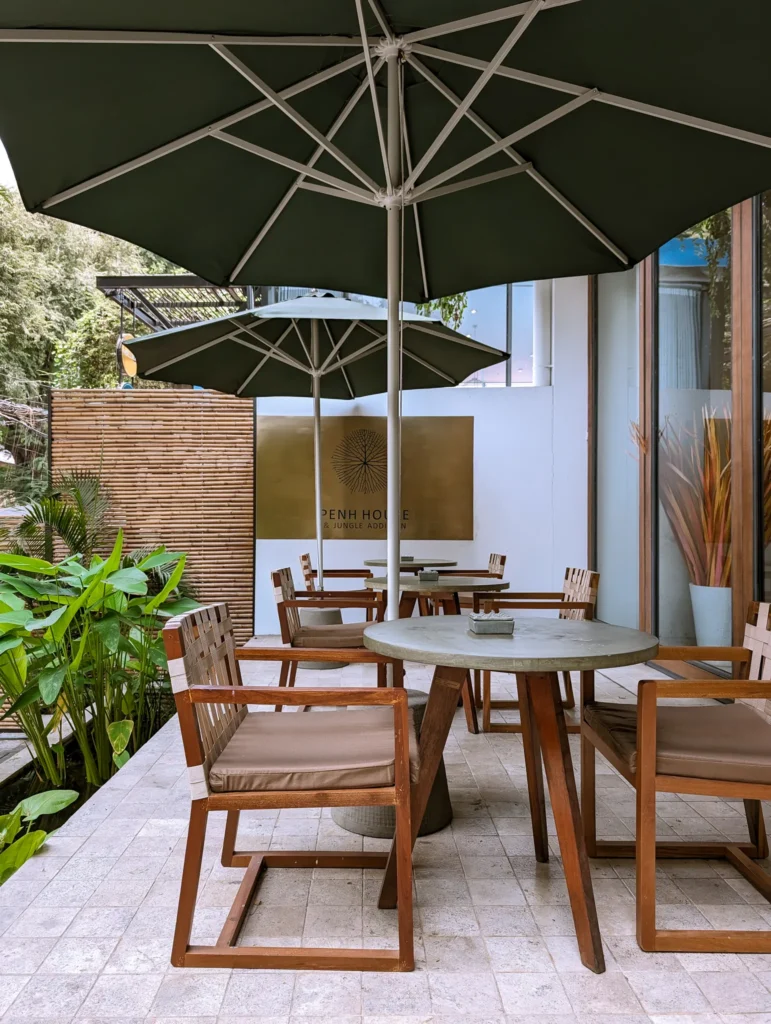
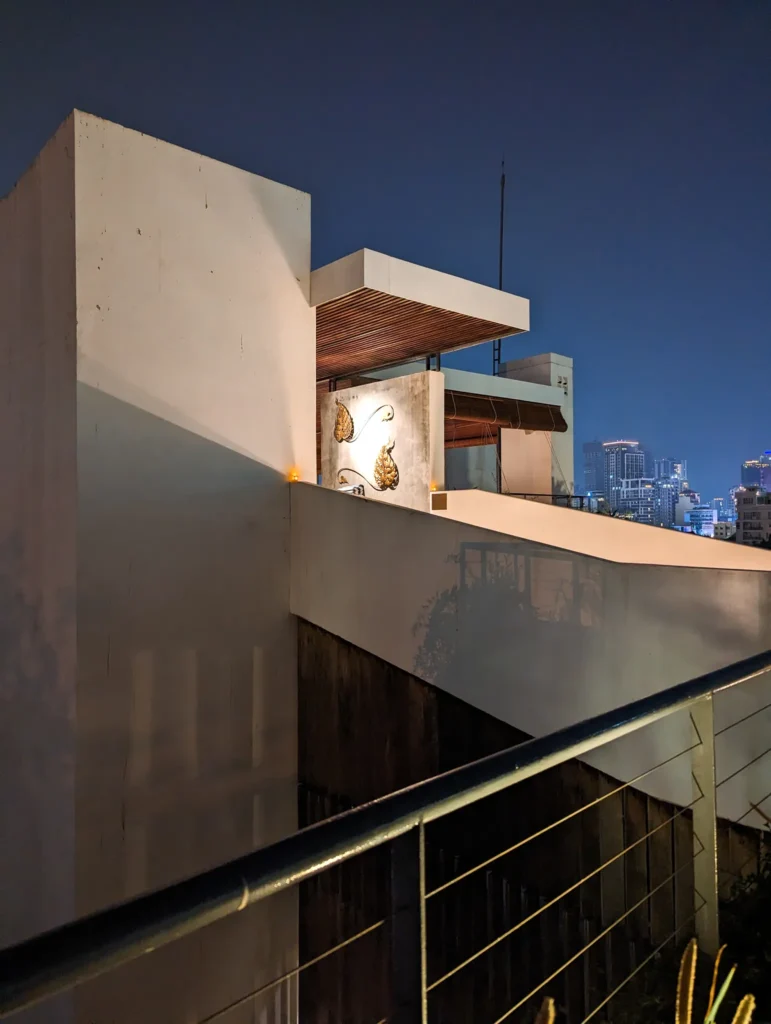

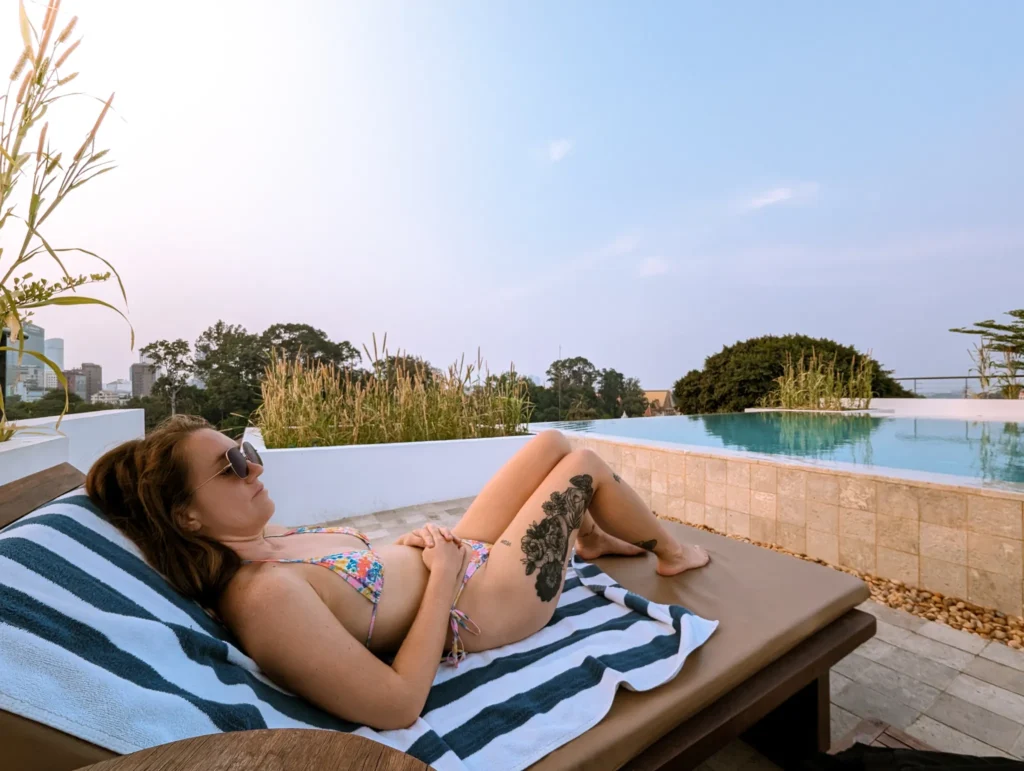
Here are some additional hostels and hotels that I can recommend:
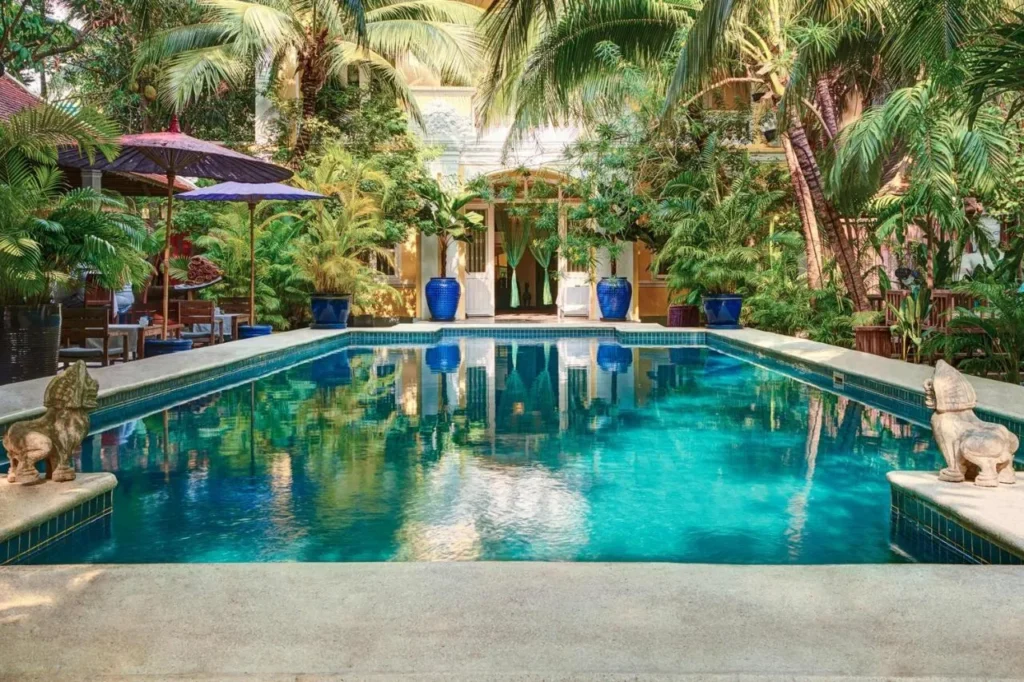
Photo courtesy of The Pavilion via Booking.com
Penh House Hotel Sister Property: The Pavilion (9.1⭐️)
The Pavilion is a sister property to Penh House Hotel and it’s another gorgeous place to stay in Phnom Penh. It features a pool bar and very good breakfast. Not to mention – it’s ‘Adult’s Only’ which is a huge selling point in my opinion!
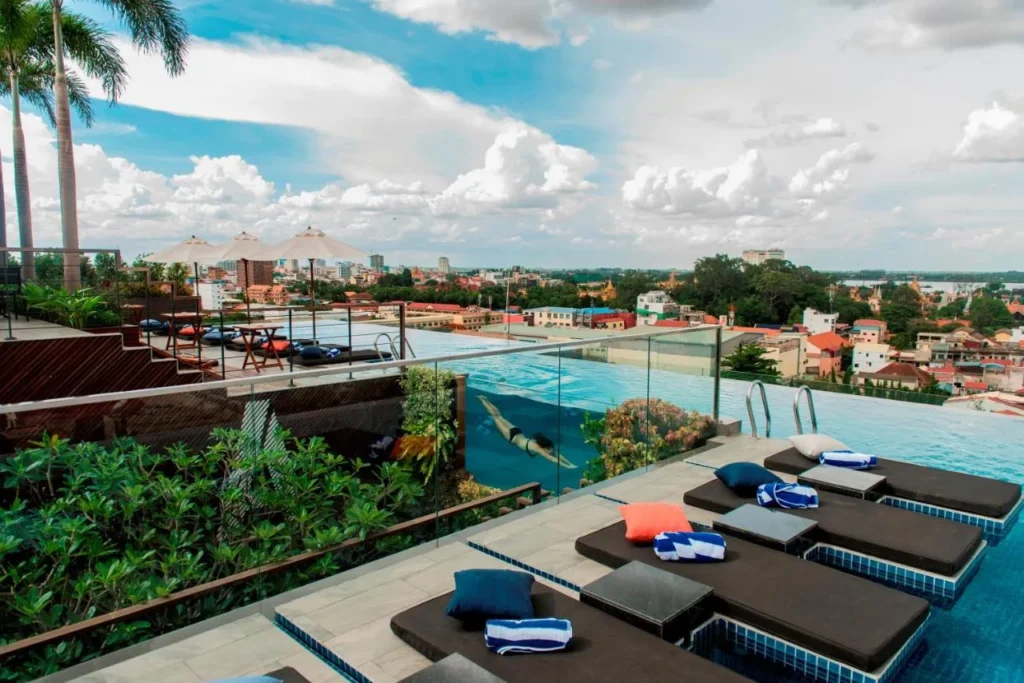
Photo courtesy of Aquarius Hotel and Urban Resort via Booking.com
Best Luxury Stay: Aquarius Hotel and Urban Resort (9.0⭐️)
For a luxury stay right on the river, you need to check out Aquarius Hotel. They have a gorgeous rooftop pool, well-equiped rooms, very good breakfast and fast wifi throughout the hotel.
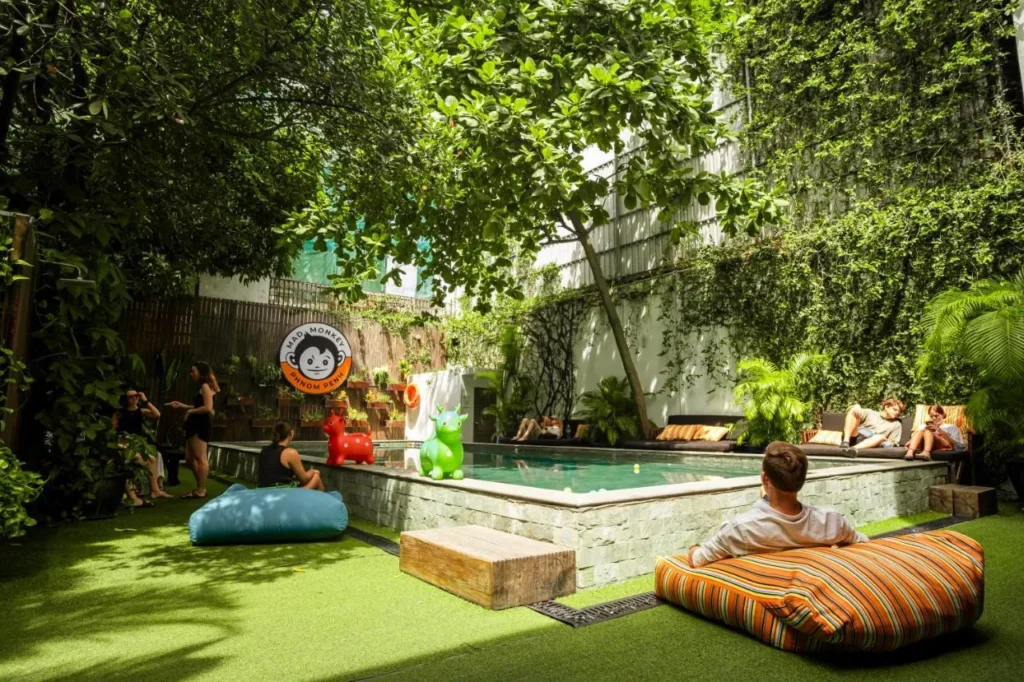
Photo courtesy of Mad Monkey Phnom Penh via Booking.com
The Top Hostel: Mad Monkey Phnom Penh (8.2⭐️)
It’s a party hostel, I know! But I recommend it because it’s in a nice neighborhood of Phnom Penh. The hostel I wanted to recommend didn’t survive COVID unfortunately. Mad Monkey also has affordable private rooms, giving you a chance to escape the party.
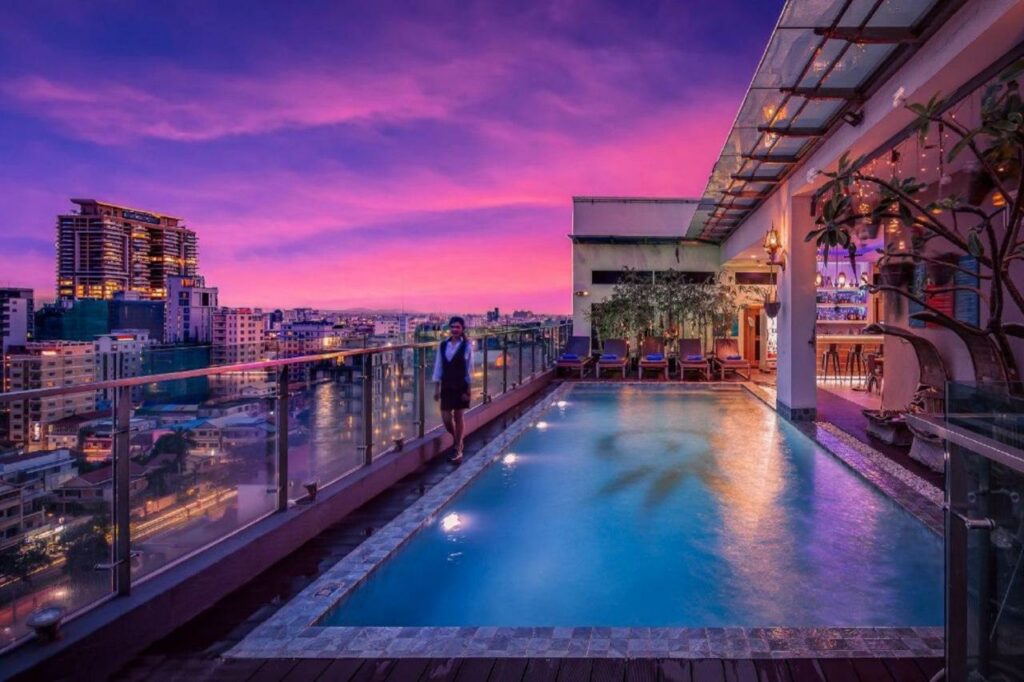
Photo courtesy of Orussey One Hotel & Apartment via Booking.com
The Best Hostel: Orussey One Hotel & Apartment (8.0⭐️)
Featuring a rooftpool and fitness center, this hotel is well located for your first trip to Phnom Penh. You can find affordable rooms with an excellent breakfast included in the price.
48 Hours in Phnom Penh Itinerary
Quick note: feel free to mix these days up! If you’ve just landed you might want to have a slower start to your explorations. In that case, do day 2 first.
Day One in Phnom Penh
It would be a mistake to go to Cambodia and not learn about the Khmer Rouge, Pol Pot and the civil war. It would also be a mistake not to learn about the world and the US’s role in Cambodia during the Vietnam War. While this will be the heaviest day of your travels, I recommend dedicating a day to these museums and memorials.
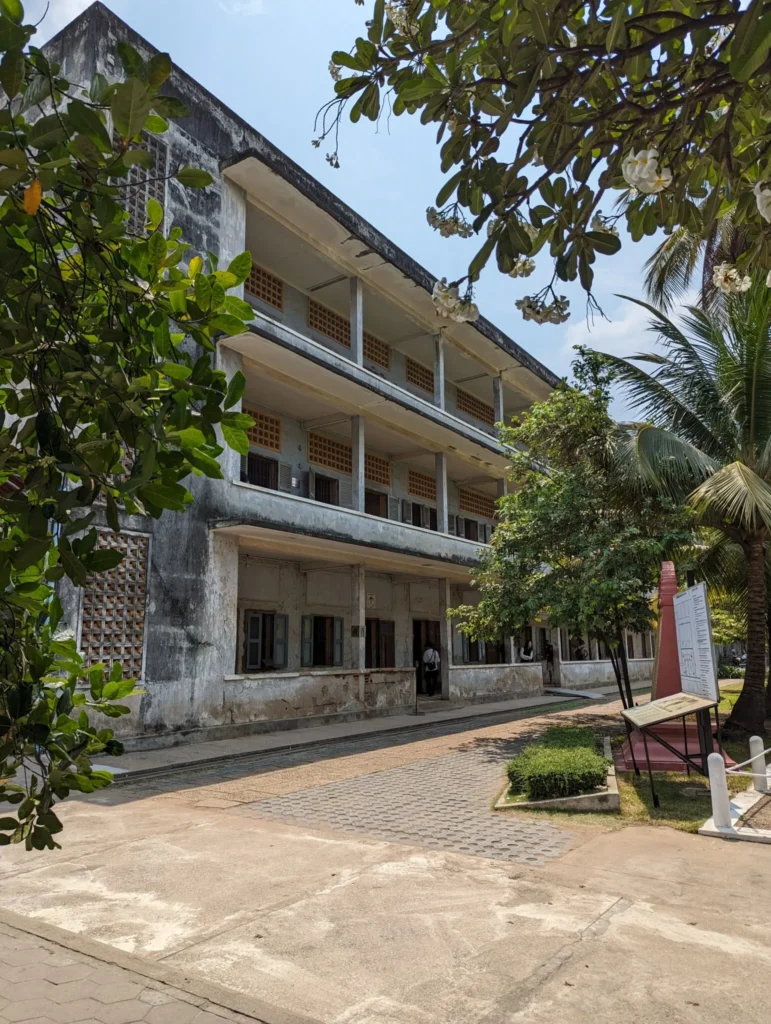
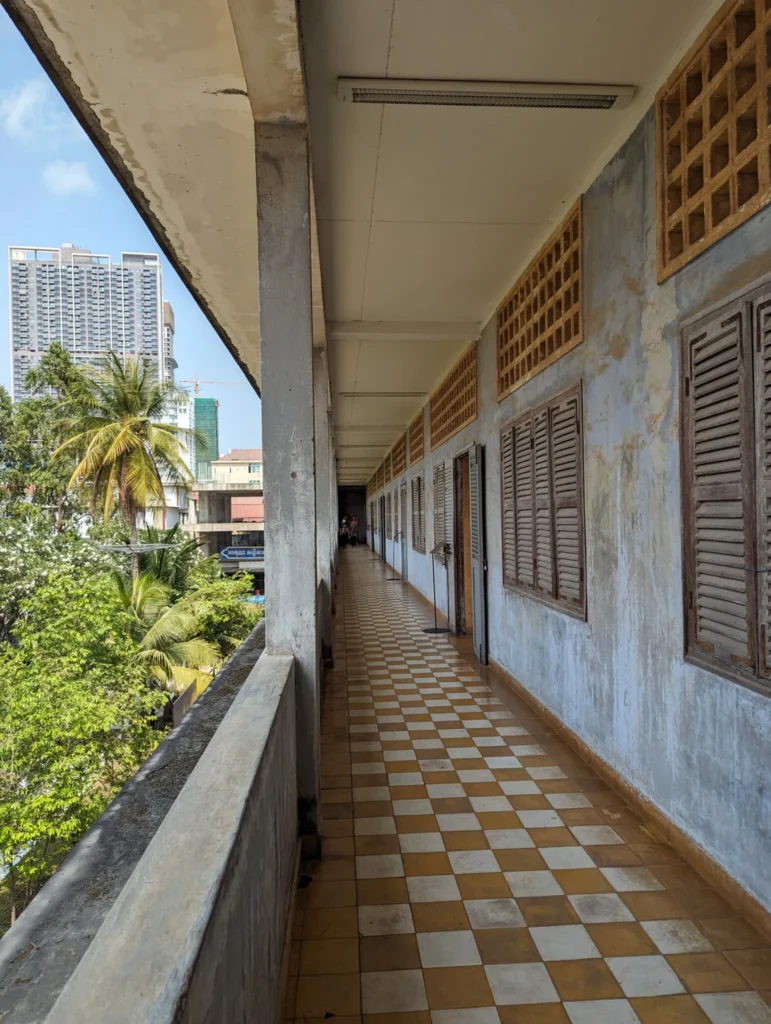
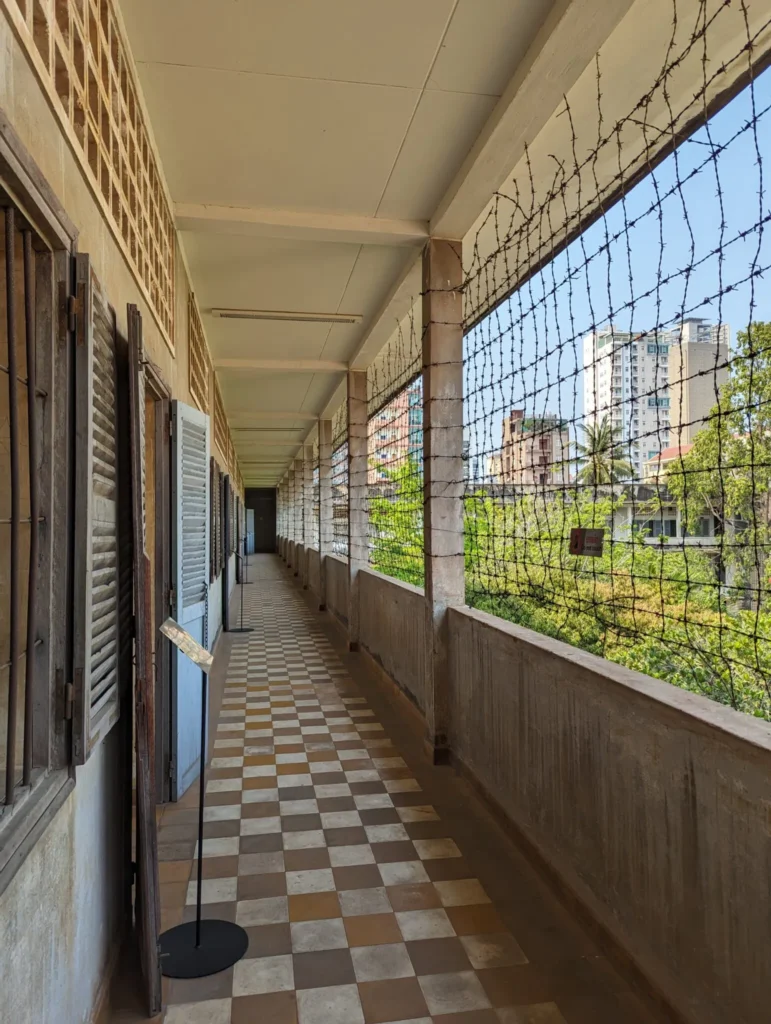
Tuol Sleng Genocide Museum (S21)
Wake up early, eat a good breakfast at the hotel and then hop in a TukTuk to Tuol Sleng Genocide Museum.
It’s a good idea to start early because both of these museums are mostly outdoors, which means you will be hot by the end of your tour. You also need to dress respectfully, with tops that cover your shoulders and bottoms that cover your knees.
I recommend that you start with Tuol Sleng, because that is where people started when they were captured and imprisoned by the Khmer Rouge. Tuol Sleng was a school in Phnom Penh before it was transformed into a prison where horrible acts of torture were committed. After people were tortured into giving false confessions, they were sent to the Killing Fields to be murdered.
Tuol Sleng comprises 4 buildings around a courtyard. Some of the rooms are filled with photos of the prisoners while others are still composed of the cells that people were held in.
I would urge you to explore on your own, with the audio guide. It’s a very heavy place to visit and the audio guide is extremely well done. You’ll want to take your time, listen to the stories on the benches and have quiet around you to reflect on the experience.
We spent close to 3 hours at Tuol Sleng.
Museum Information:
- Location: St 113, Phnom Penh 12304, Cambodia
- Opening hours: 8AM-5PM / 7 days a week
- Other names: S-21
- Number of inmates: 18,145 prisoners (though probably even more)
- Entrance cost: $5.00 (for nonCambodians)
- Audio guide: $5.00 (for nonCambodians)
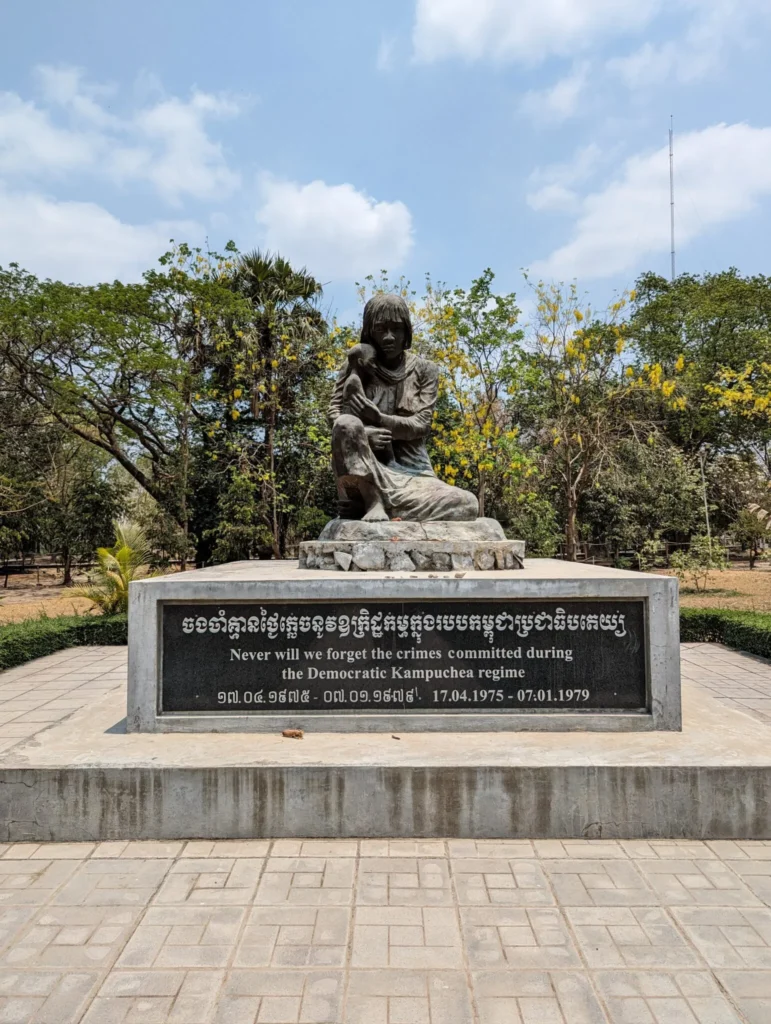

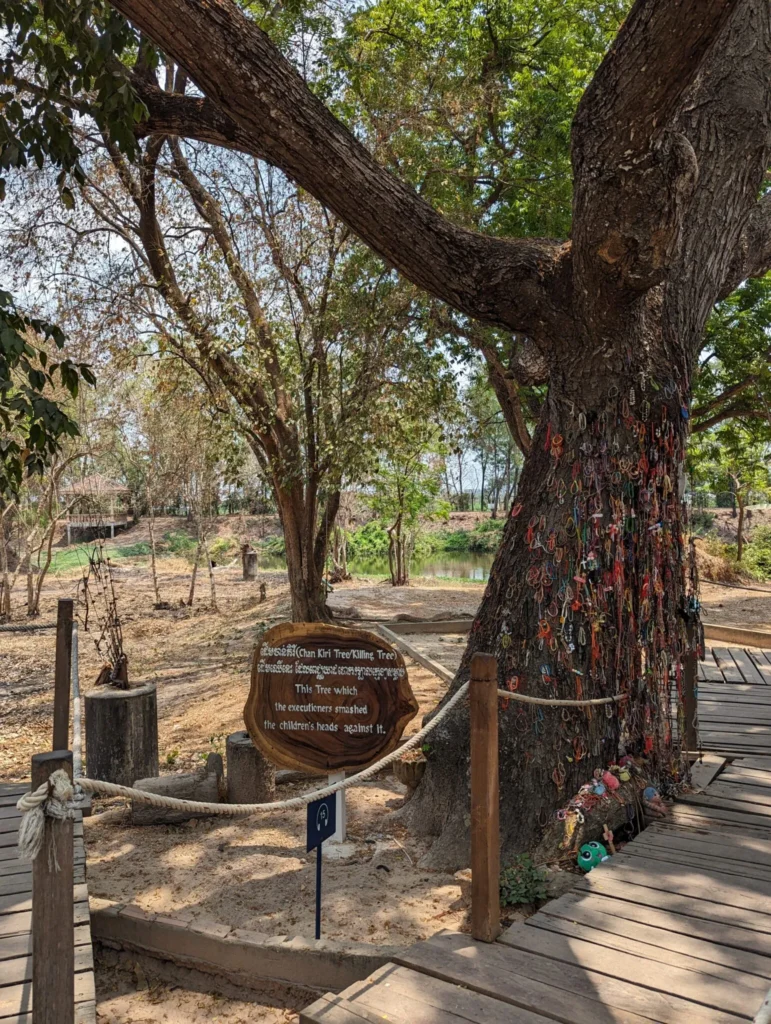
Choeung Ek (the Killing Fields)
Once you’ve finished the audio guided tour of Tuol Sleng, I recommend getting back in your TukTuk and going to Choeung Ek (or the Killing Fields).
The reason I recommend going to Tuol Sleng first is because you get to hear the stories and the history that led up to places like the Killing Fields existing. There have been 300 Killing Fields discovered around Cambodia where one million Cambodians were murdered.
Choeung Ek was a former Orchard and Chinese Cemetery outside of Phnom Penh, but during the rise of the Khmer Rouge, it became the site of thousands of murders.
Mass graves containing 8,895 bodies were discovered at Choeung Ek after the fall of the Khmer Rouge regime. (source: Wiki)
While most of the buildings were destroyed after the discovery of Choeung Ek, the audio guide takes you around the site to see what buildings would have stood and where mass graves have been discovered. They are still finding the remains of people every rainy season in Cambodia.
The Killing Fields is very much an active archeological site.
In the center stands a beautiful Pagoda that’s been erected to memorialize those who were murdered here. Inside lay hundreds of bones and strips of clothing that have been unearthed around the site.
Once again, I would urge you to choose the audio guide over a guided tour. At one point, we took our headphones off and listened to the silence all around us, even though the site was full of visitors. It’s really something to be surrounded by so many people in such a quiet and respectful manner.
Museum Information:
- Location: ផ្លូវជើងឯក, Phnom Penh, Cambodia (every Tuk Tuk driver will know)
- Opening hours: 7:30AM-5:30PM / 7 days a week
- Other names: The Killing Fields
- Opened: 1988
- Entrance cost: $6.00 (for nonCambodians) – including the audio guide
We spent close to 3 hours at Choeung Ek as well.

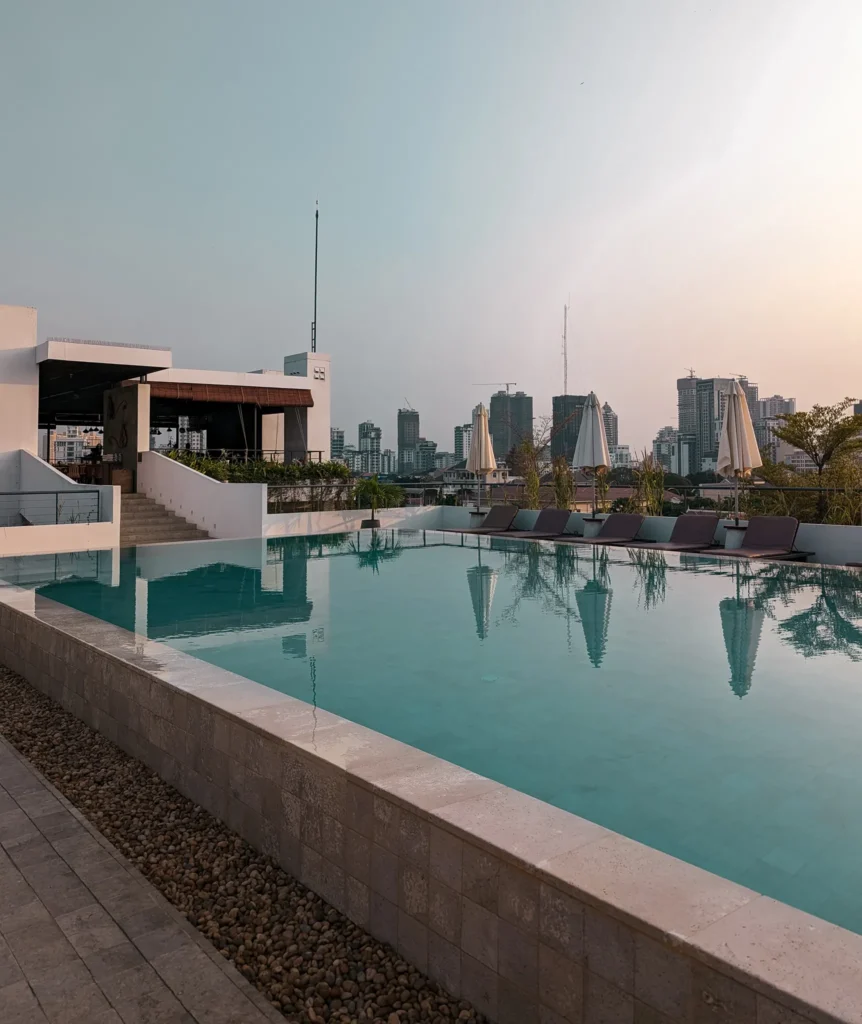
Lunch, a swim and sunset
After your visit to both of these sites, you’ll want to head back to your hotel for a rest. It’s likely the hottest part of your day, and you’ve just had a very heavy look into the Cambodian Genocide. We chose to grab an easy street food lunch and head back to our hotel to rest.
I highly recommend that you choose a hotel in Phnom Penh that has a rooftop pool. This way once your day is finished you can sit on the rooftop, swim and watch the sunset. We spent the rest of our day here. After sunset we walked down past the Royal Palace and along the riverfront to Phnom Penh’s night market.
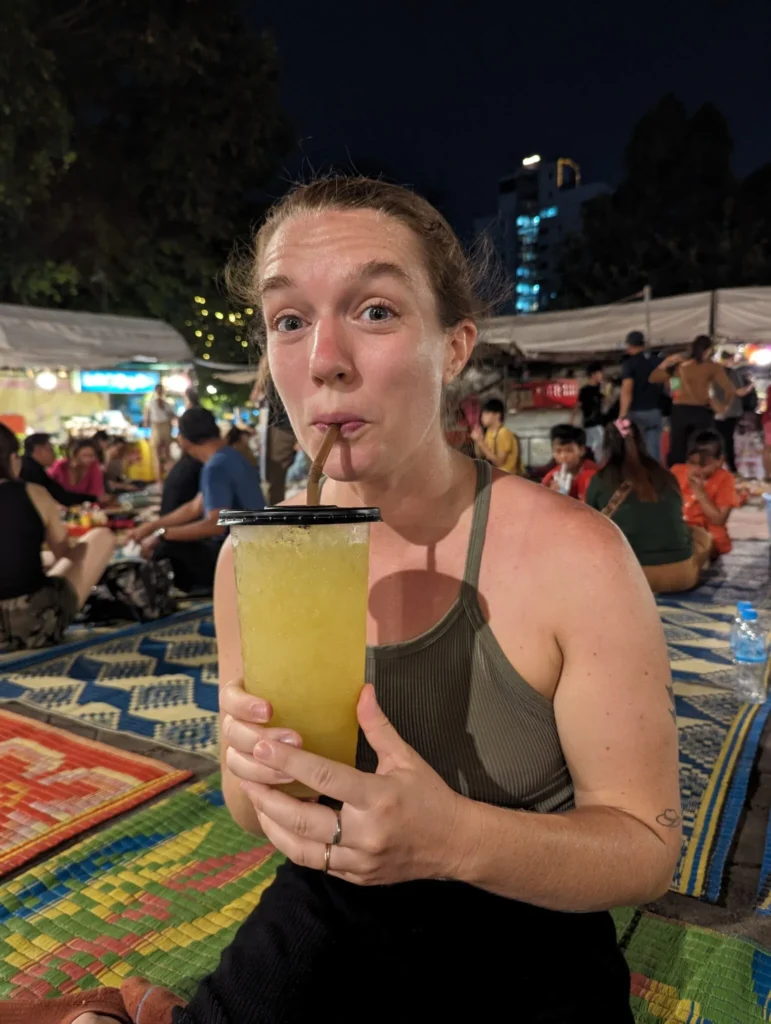

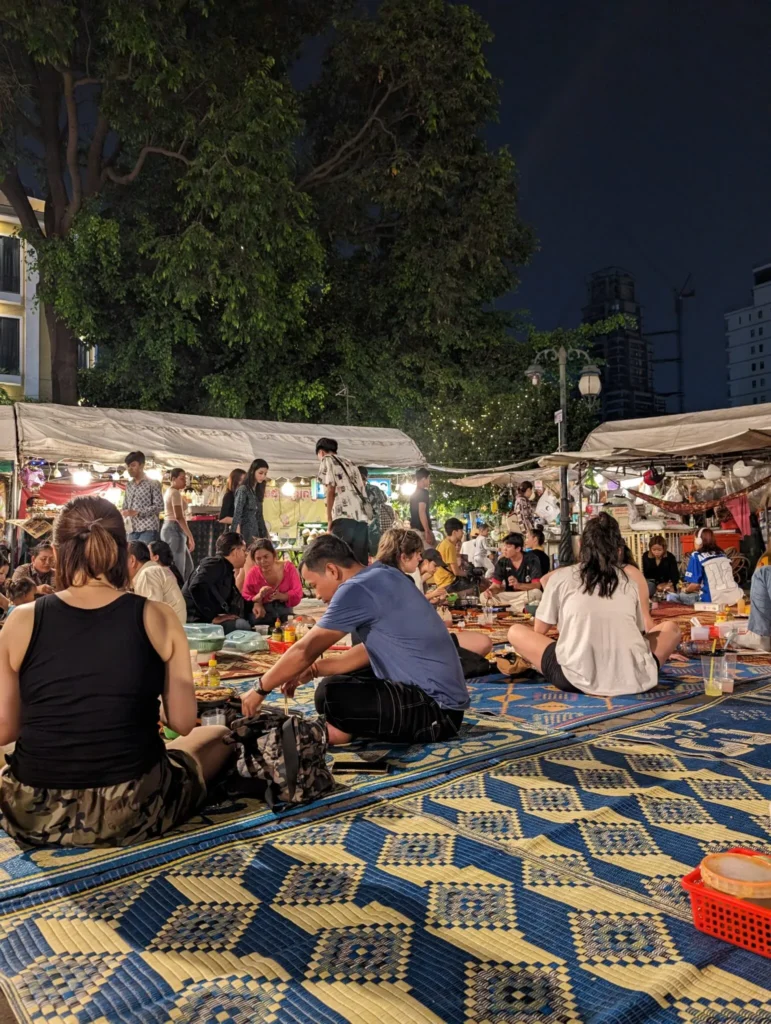
Riverfront explorations & the night market
The Royal Palace lights up at night with families and friends coming together to sit in the grass, enjoy food and run around together. It was really cool to see this lively piece of Phnom Penh. They close off the street in front of the palace and turn it into a walking street. I highly recommend visiting after dark.
We chose to walk along the riverfront all the way to the night market. The night market is not your typical, they don’t have a lot of souvenirs but instead, clothing and jewelry shops. We didn’t do much shopping but I did love the huge communal food area. You pick a joint, take your shoes off and plop down on a rug. I’ve never seen a night market food section quite like it!
After a quick bite and a delicious sugar cane juice (my new obsession), we headed out in search of a local bar to sit and have a beer. Unfortunately, this is where Phnom Penh let us down. After leaving the night market we quickly realized that we’d stumbled into the ‘Red-Light District’ of Phnom Penh.
Altogether, we found that this area of Phnom Penh had either seedy red light district bars, or very expensive rooftop bars. After searching for a cheap beer like we’d gotten used to in Siem Reap, we finally gave up and decided to head home and drink a beer on our balcony instead.
Day Two in Phnom Penh
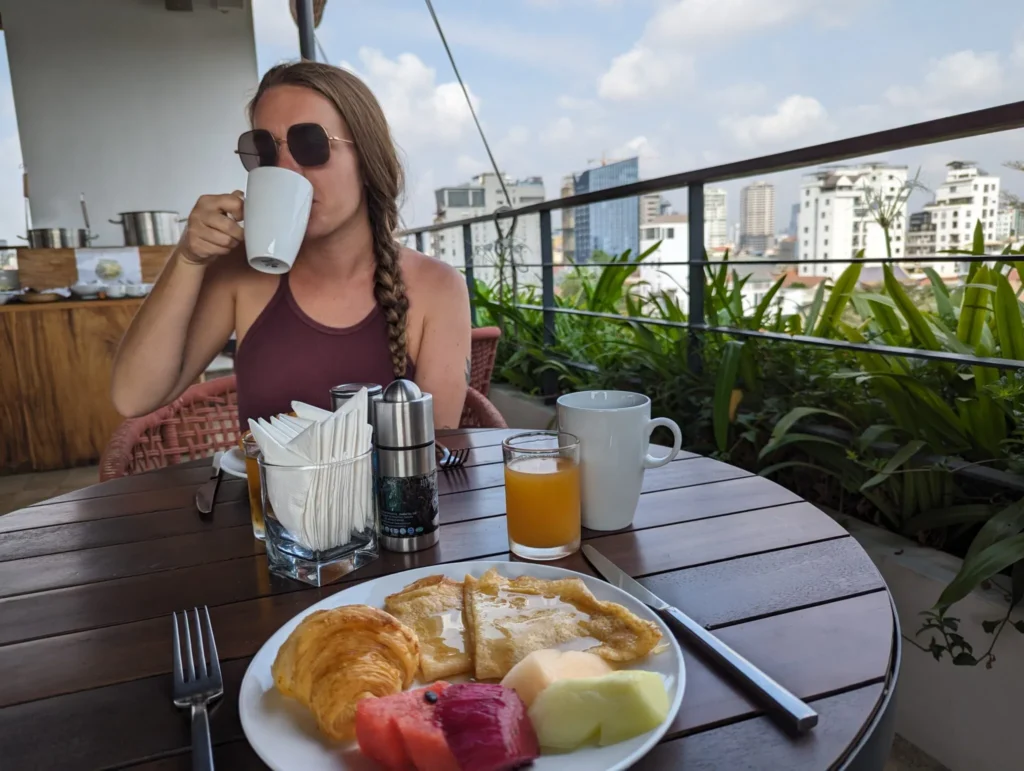
Coffee and shopping along Street 240
Street 240 is home to gorgeous boutiques and cafes! I recommend starting your day with a little shopping. What I loved about this street is that it was home to shops that clearly cared about local Cambodian people and culture. This street is full of shops whose products are made by Cambodian people paid a fair wage, with high quality materials. It’s the perfect place to shop before you leave the city.
After shopping, pick one of the cute cafes along the street for a coffee or visit WAT chocolate for a sweet treat!
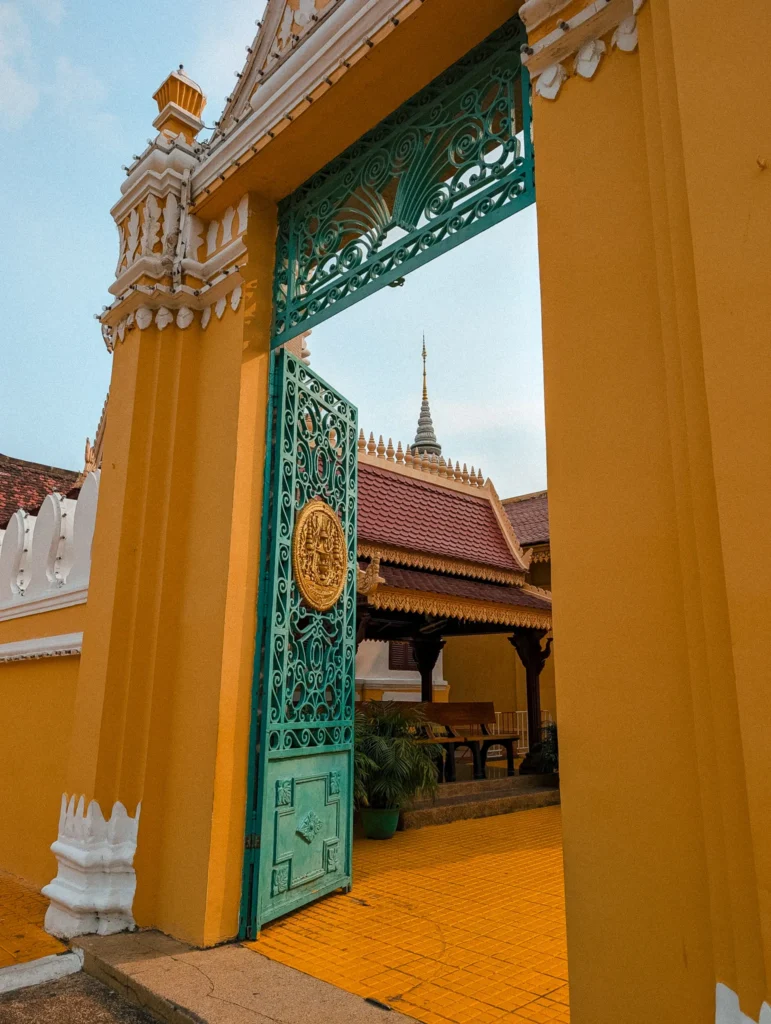
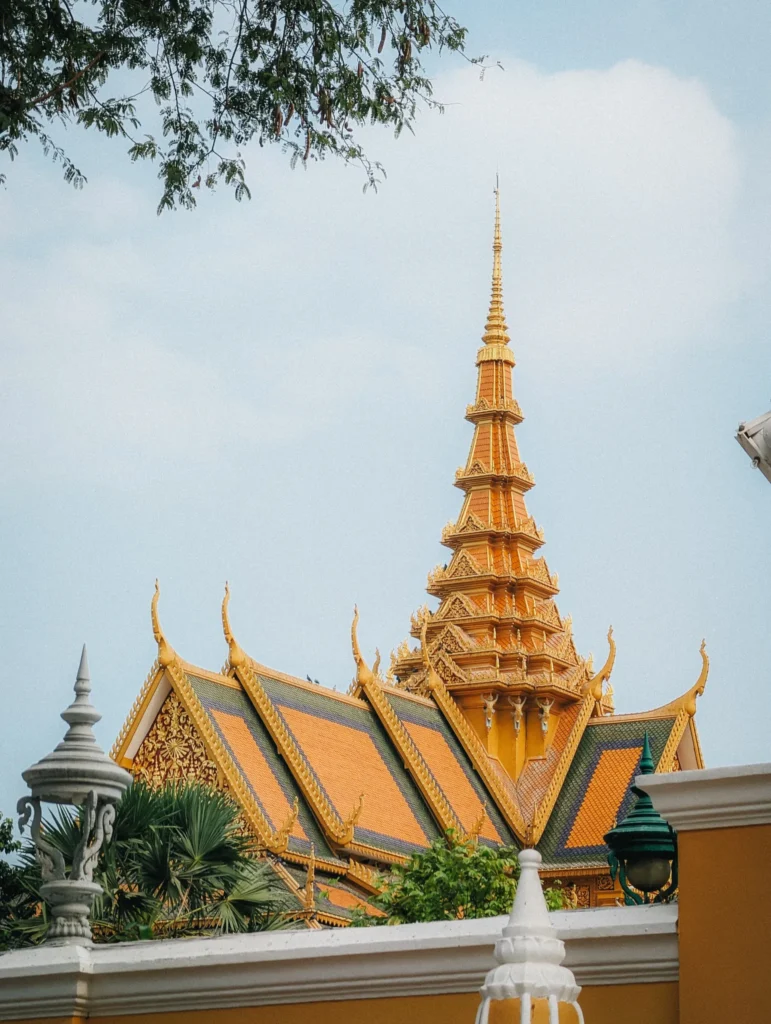
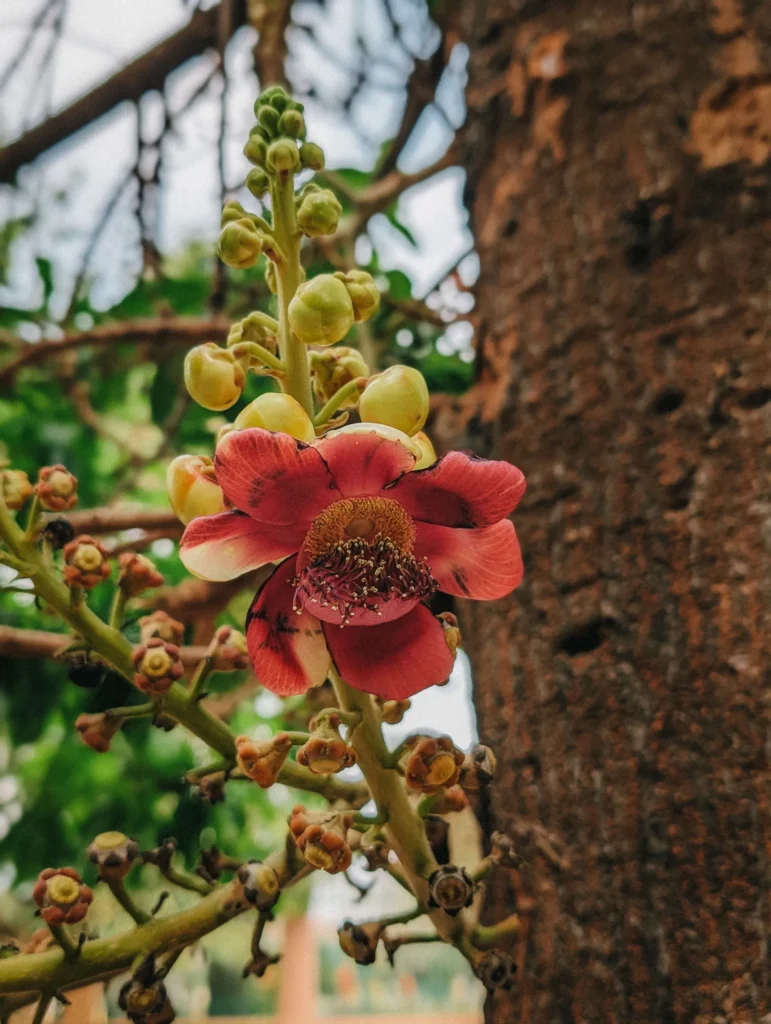
Exploring the Royal Palace and Silver Pagoda
The Royal Palace is definitely an icon of Phnom Penh. Each evening the front lawn comes to life as a picnic spot for local families, so it’s a great place to hangout, eat food and people watch. If you want to take pictures along the golden walls without crowds, come while the palace is closed, between 10AM-2:30PM.
If you want to explore inside the palace, go in the afternoon slot. When we were exploring, it was a lot less crowded during the afternoon slot. This is why I recommend doing your shopping in the morning, and exploring the royal palace during the later slot.
Palace Information:
- Location: Samdach Sothearos Blvd (3), Phnom Penh, Cambodia
- Opening hours: 7–10 AM, 2:30–4:30 PM / 7 days a week
- Entrance cost: $10
- Style: Khmer architectural style
- Function: Palace

The National Museum of Cambodia
The National Museum of Cambodia is home to the largest collection of Angkorian antiquities. If you’re heading to Siem Reap next, you’ll be getting a deep dive into the history of the unique and beautiful temples of Angkor Wat.
The building itself is gorgeous and visiting, even if you decide not to check out the exhibits. You can walk around the grounds and explore the gardens in front of the museum.
Museum Information:
- Location: Preah Ang Eng St. (13), Phnom Penh 120211, Cambodia
- Opening hours: 8AM-5PM / 7 days a week
- Entrance cost: $10
Walk along the Riverfront
After exploring the museum and Royal Palace, take a walk along the riverfront. It’s such a lively part of the city, perfect for people watching and slowing down a bit. These last two days in Phnom Penh were full and hectic! Sometimes it’s nice to just walk around for a while and take it all in.
Sunset Cocktails
If you’re staying at Penh House Hotel, head back to the rooftop for sunset cocktails. If you’re not staying at a hotel with a rooftop bar, stop by Juniper Gin Bar for a sunset drink overlooking the city. It’s quite a nice skyline, especially when you can see the Royal Palace from up high, so it’s worth doing on your last night!
Juniper Gin Bar is located on the 12th and 13th floor so it has a perfect vantage point for sunset over Phnom Penh. We were feeling really wiped out after our two very full days, so we decided on our last night to have sunset cocktails and dinner at Penh House.
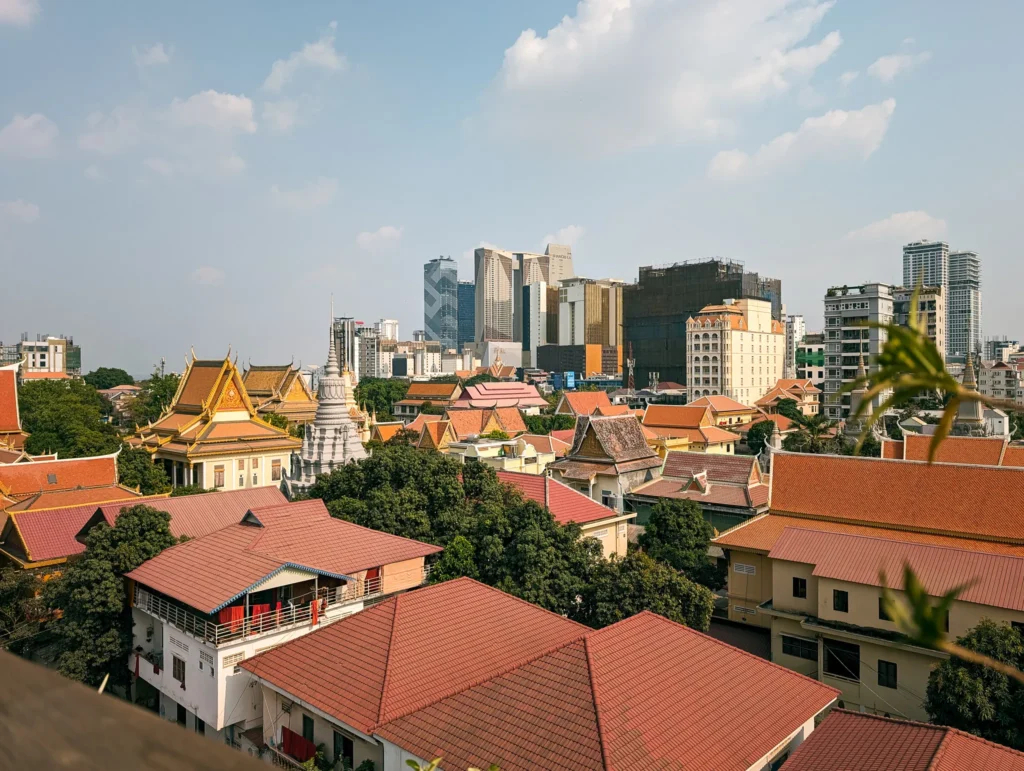
Optional Additional Activities
If you have more time to explore, you might want to do some other activities. I definitely feel like this itinerary has a very “first-time in Phnom Penh” vibe. But it ticks all the boxes of the things that I wanted to see and do during my trip.
After doing a bit of research, if I was to go back I would look at doing some of these activities:
You could also add any of those activities to the 48 hour itinerary if you have the energy during your trip!
Book an activity for Phnom Penh here:
Cost of travel in Phnom Penh
Daily Budget
Phnom Penh felt a lot more expensive than other parts of Cambodia that we traveled (including Siem Reap!) The hotels definitely cost a bit more, and food and drink across the city was closer to European prices than what you’re used to in South East Asia.
🏨 Hotel room: $50 – $100 a night
🛏️ Hostel room: $10 – $20 a night
🍛 Lunch / Dinner: $3 – $20
🍻 Beer: $1.5 (local beer) / Cocktail: $6 – $8
🚰 Drinking water: $0.80 for 1.5L
🛺 TukTuk: $1.00 – $3.00 a trip
🚂 Intercountry Buses: $10 – $15
Overall the entrance fees to all of the museums was what really ate into our budget! We spent $177.14 for two people, for 48 hours in Phnom Penh (not including accommodation which was $90/night). You can definitely do it cheaper than we did, but the biggest cost for us ended up being the museums and sightseeing in the city! And our fancy rooftop dinner on our last night.
What to wear in Phnom Penh
Throughout Cambodia you’ll need to have modest clothing that covers your shoulders and knees. To visit the memorials, museums and temples in Phnom Penh, they’ll require you to dress appropriately. Come prepared and be respectful of their sites.
In Thailand, I’ve seen people turned away from temples and museums for not being dressed appropriately. In Cambodia, they would still let you in, even if you weren’t following the dress code. But trust me, you’ll stick out like a sore thumb. And, it looks disrespectful to their memorials.
That being said, just make sure you have plenty of flowy, lightweight outfits to wear. I love linen for the hot weather and make sure to keep a lightweight white shirt with me that I can always throw over my shoulders. It’s always good to have a lightweight maxi dress, linen pants and a couple of tee shirts that you don’t mind getting sweaty!
5 Things to Pack for Phnom Penh
Walking shoes. Trust me, even though Phnom Penh isn’t the most walkable city, you are going to want a very good pair of walking shoes for your trip.
Modest, lightweight clothing and a scarf for visiting the temples and memorials. It’s very important to dress modestly in Cambodia. You are going to want flowy, lightweight pants, lightweight tops with sleeves, and a scarf that you can use to cover your shoulders. Keep in mind that for some temples, simply covering your shoulders with a scarf won’t be enough. You’ll need to wear modest clothing.
A reusable water bottle. Cambodia definitely suffers from plastic pollution, but the tap water is drinkable in Phnom Penh! Make sure that you bring a reusable water bottle. Most restaurants (and Penh House Hotel) will be more than happy to refill it for you. I love this water bottle because it comes with a lid for coffee or a smoothie!
Hydration salts/Liquid IV. It gets very hot and on days spent exploring, it can be really easy to get dehydrated. I always keep some hydration salts in my purse (or if I’m lucky, LiquidIV).
Wet wipes and tissues. Bathrooms across South East Asia don’t usually have toilet paper, so I like to keep wet wipes and tissues in my purse. It also doesn’t hurt to carry hand sanitizer.
Read next: My Favorite Hotel in Phnom Penh
Are you ready to spend 48 hours in Phnom Penh? I hope this itinerary has inspired your trip. If you’re adding Phnom Penh to your bucket list, make sure to save this post to Pinterest and follow me for more travel inspiration.
More Asia Guides:
- The Perfect 4-Day Siem Reap Itinerary
- Spend a Week in Koh Samui
- Digital Nomad Guide to Koh Tao
- 10-Day Cambodia Itinerary
- The Perfect 3-Day Hanoi Itinerary
Love this travel guide? Much like a cup of coffee, I pour my heart and soul into each post! Say thank you by buying me a cup of coffee. Support this blog and keep it ad-free.
